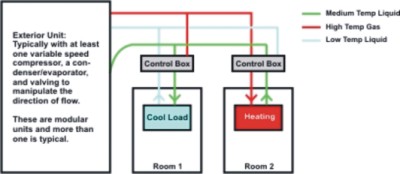
Although variable refrigerant flow (VRF) is not a new technology, it is somewhat new to the US, and probably you as well.
This system essentially consists of air source heat pump(s), but instead of many units, one compressor serves multiple condensers and evaporators. A refrigerant coil in a space can either act as a condenser for heating or evaporator for cooling depending on how automatic valves direct refrigerant flow based on space temperature needs. These heat pumps may only be a little more than half as efficient as ground source heat pumps, but there are potential advantages depending on the application.
The Good
Since VRF systems use refrigerant, there is a large reduction in the size of the ducting or piping needed to maintain temperatures in the space over conventional central air handling systems. Air systems need a lot of volume to move the same amount of thermal energy as water, and even more volume to move the same amount of energy as refrigerant (heating or cooling). A typical VRF outside unit has a 3 ft X 3 ft base and is 6-7 ft tall, which makes it fairly small and relatively easy to transport and install compared to other conventional systems.
The Not So Good
The good often comes with the not so good. The major disadvantage with an all-refrigerant system is that refrigerant is on the pricy side whereas air and water are free (or relatively inexpensive). There is also more refrigerant required as it is piped from central outdoor units to each zone in the building. Another drawback is that because this is an all-refrigerant system, it increases the likelihood of refrigerant leaks. Also, this type of system, like many other air cooled heat pump systems, does not perform well in very cold climates, so back up heating will typically be needed to support it.
The Good Again
To really take advantage of this type of system there must be many hours of the year when some zones need cooling while others need heating. This results in useful thermal energy movement for both evaporator and condenser whereas conventional systems throw one or the other away, always. Shown to the left is a simplified account of how this system would handle heating and cooling simultaneously per zone needs. If both spaces were either in heating or cooling, the exterior unit would take and return the entire refigerant flow.
Summary
In the right applications with extended periods of simultaneous heating and cooling required among diverse zones, this type of system can have many more benefits than drawbacks.




